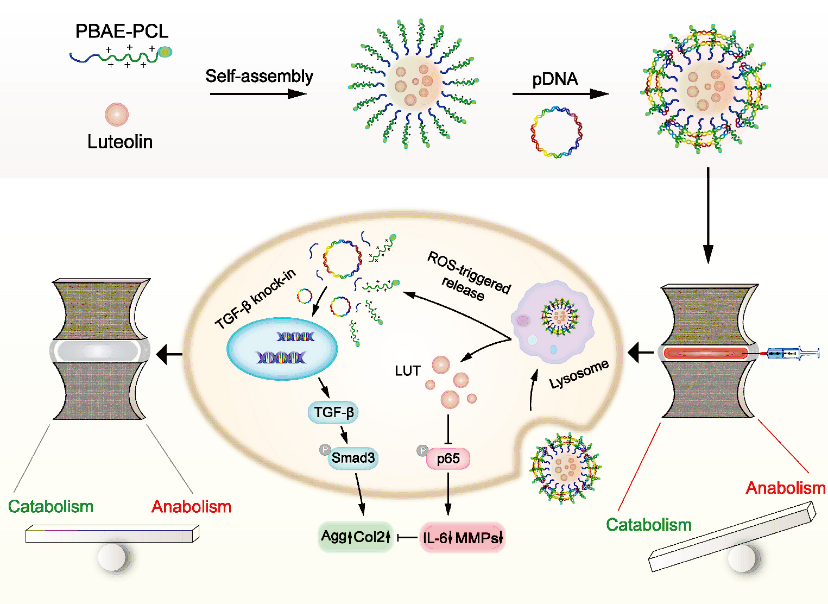On the back cover of the ninth issue of 《Nano Research》, the latest research results of TAN Songwei, associate professor of the School of Pharmacy are published, titled 《Co-delivery of luteolin and TGF were published- β 1 plasmids with ROS-responsive virus-inspired nanoparticles for microenvironment regulation and chemo-gene therapy of intervertebral disc degeneration》.

Low back pain (LBP) is a very common disease, which affects at least 70% of the world population more than once in their lifetime and causes heavy economic burden to patients. It could even lead to severe disability and deterioration in patients’ quality of life. LBP is often associated with intervertebral disc degeneration (IDD), also known as discogenic LBP. IDD accounts for about 40% of LBP.
The causes of IDD are very complex, including genetic, environmental, and other factors. At present, it is considered that the functional decline in nucleus pulposus cells (NPCs) caused by nucleus pulposus inflammatory microenviroment and the cascade reaction induced by the imbalance of synthesis/catabolism of extracellular matrix(ECM) are the main reasons for IDD.
There are currently two ways used to treat IDD: conservative treatment and surgical treatment. Conservative treatment is mainly the application of non-steroidal anti-inflammatory drugs(NSAIDS),physical therapy, etc. It can relieve patients’ pain to some extent, but cannot prevent the progress of IDD. This shows that its effect is limited. The other treatment, surgical treatment, includes intervertebral disc (IVD) removal, spinal fusion, and artificial IVD replacement. Although it can produce satisfactory results, it is highly invasive and tends to accelerate adjacent disc degeneration. Thus, it is necessary to develop new strategies for IDD treatment.
IDD is closely related to inflammation and imbalance of synthesis/catabolism of extracellular matrix (ECM) in intervertebral disc (IVD). Considering this, luteolin (LUT), a kind of natural flavonoid with good anti-inflammatory effect and TGF-β1 (a gene that promotes the regeneration of ECM) plasmid was co-loaded and co-delivered to nucleus pulposus cells (NPCs). Reactive oxygen species (ROS) responsive cationic copolymer, poly(β-amino ester)-poly(ε-caprolactone) (PBC), with high plasmid DNA (pDNA) compression affinity was synthesized. It can self-assemble into nano-sized polyplexes (pDNA@PBC) with virus-inspired structure and function through which it can transfect pDNA into NPCs with very high efficiency and negligible cytotoxicity. LUT was encapsulated in the hydrophobic core of pDNA@PBC. The co-delivery system, LUT-pTGF-β1@PBC, could enhance the cellular uptake of NPCs and manifest excellent sustained drug release in IVD. Real time quantitative polymerase chain reaction (RT-qPCR) and Western blot experiments reveal that the co-delivery system could inhibit inflammation in NPCs and restore the balance of anabolism and catabolism in vitro by activating TGF/SMAD3 and inhibiting NF-kB/p65. Moreover, LUT-pTGF-β1@PBC retards IDD in vivo as detected by radiological and histological methods with good biosafety in rats. LUT-pTGF-β1@PBC may be a promising option for the treatment of IDD.

Professor TAN Songwei and Professor FANG Huang of Tongji Hospital are the co-corresponding authors of the paper. DING Yifan, a doctoral student of Tongji Hospital, and WANG Huan, an associate chief physician are the co-first authors. The research is supported by the National Natural Science Foundation of China. (Written by ZHANG Zhiyong)
Paper link:https://doi.org/10.1007/s12274-022-4285-7
